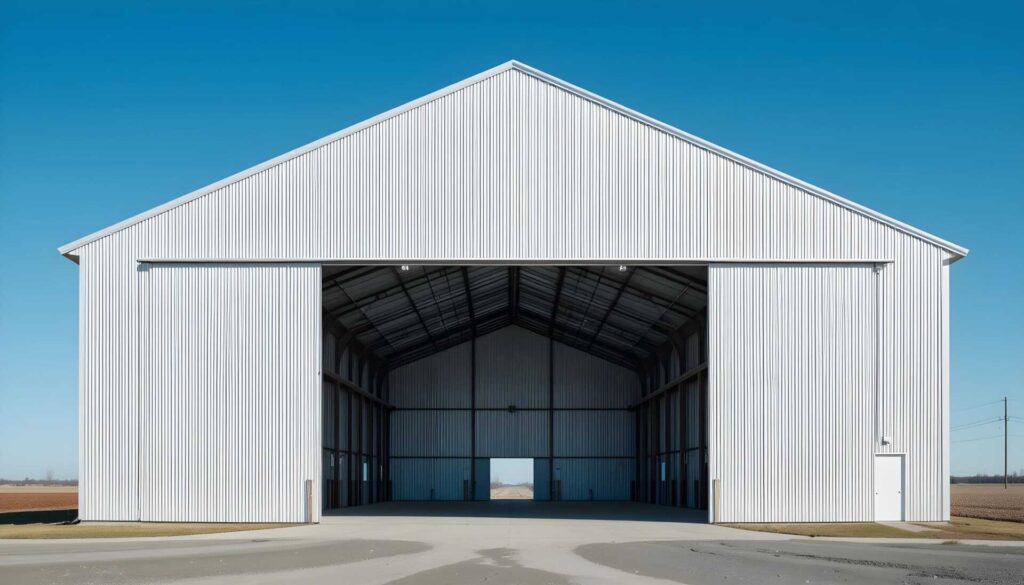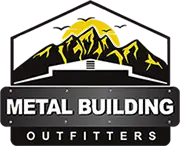
Contents
When you’re considering constructing durable agricultural metal structures, the choices you make about materials and design can greatly impact longevity and efficiency. You’ll want to select high-quality metals that resist corrosion while ensuring proper insulation and airflow for your livestock. Advanced construction techniques play an essential role, but there’s more to it than just the basics. What unexpected factors could influence your project’s success or failure? Exploring these aspects can reveal insights that might change how you approach your next build.
Key Takeaways
- Use high-grade galvanized or stainless steel to ensure corrosion resistance and enhance the longevity of agricultural structures.
- Design for optimized airflow to improve livestock comfort, health, and productivity while reducing heat stress.
- Incorporate insulation and energy-efficient materials to maintain stable temperatures and lower energy costs.
- Adhere to local regulations and standards to ensure safety and compliance in construction.
- Regular maintenance and inspections are vital for identifying wear and ensuring the structural integrity of metal buildings.
Benefits of Metal Structures
While you might initially consider traditional materials for agricultural structures, metal offers numerous advantages that can enhance both efficiency and longevity. One of the most significant benefits of metal is its sustainability. Metal structures are often fabricated from recycled materials, reducing the demand for new resources and minimizing waste. This aligns with modern agricultural practices that prioritize eco-friendliness. By choosing metal, you’re contributing to a more sustainable future for your farming operations.
In addition to sustainability benefits, metal structures provide exceptional energy efficiency. They can be designed to optimize natural light, reducing the need for artificial lighting during the day. This lowers energy costs and creates a more pleasant working environment.
Insulated metal panels can further enhance energy efficiency, maintaining stable temperatures and reducing heating or cooling expenses. You’ll find that these features are especially beneficial for livestock facilities, where climate control is vital for animal welfare.
Moreover, metal’s durability means reduced maintenance costs over time. Unlike wood, which can warp, rot, or be susceptible to pests, metal withstands harsh weather conditions and requires minimal upkeep.
This resilience translates into a longer lifespan for your structures, ultimately saving you money.
Selecting Quality Materials
Selecting quality materials is essential for the longevity and functionality of agricultural metal structures. When you commence on the journey of constructing these structures, your approach to material sourcing will considerably impact the overall performance and durability of the final product.
Start by identifying suppliers that prioritize high-grade metals, such as galvanized steel or stainless steel, which offer superior resistance to corrosion and wear.
It’s vital to conduct thorough durability testing on the materials you plan to use. This testing ensures that the metals can withstand environmental stresses, including extreme temperatures, moisture, and heavy loads.
Look for results from standardized testing methods, such as tensile strength assessments and fatigue tests, which provide insights into how the materials will perform over time.
In addition to sourcing robust metals, consider the coatings and treatments applied to enhance their durability. For example, powder coating can provide an extra layer of protection against rust and UV damage, extending the lifespan of your structures.
Don’t overlook the importance of certifications and industry standards. Confirming that your materials meet or exceed these benchmarks can help you avoid potential pitfalls.
By prioritizing quality in your material selection process, you’re not just investing in a structure—you’re fostering a reliable environment for your agricultural endeavors.
Ultimately, this commitment to quality will resonate with your peers, reinforcing a sense of belonging in a community that values durability and innovation.
Design Considerations
Designing agricultural metal structures requires careful contemplation of various factors to guarantee ideal functionality and efficiency. You need to keep in mind the structure’s purpose, local climate, and overall aesthetic appeal, as these elements considerably influence the design process. Below is a table that outlines key considerations to help guide your design:
| Factor | Description | Importance |
|---|---|---|
| Purpose of Structure | Define the primary use (e.g., storage, livestock) | Assures functionality meets needs |
| Local Climate | Assess weather conditions (e.g., wind, snow load) | Affects durability and safety |
| Environmental Impact | Evaluate materials and construction methods | Promotes sustainability and reduces footprint |
When designing, think about how the structure interacts with its environment. For example, integrating natural light can enhance aesthetic appeal and reduce energy consumption. Selecting materials with minimal environmental impact aligns with sustainable practices and resonates with community values.
Additionally, ascertain your designs adhere to local regulations and zoning laws, as compliance is essential for long-term viability. You’ll also want to take into account future expansion possibilities, assuring the structure can adapt to changing agricultural needs. By focusing on these design considerations, you set the stage for constructing metal structures that fulfill both functional and aesthetic requirements, ultimately fostering a sense of pride and belonging in your agricultural community.
Customization Options
Customization options for agricultural metal structures are essential for tailoring designs to specific operational needs and preferences. By selecting custom design features, you can guarantee that your structure meets the unique demands of your agricultural practices. Whether it’s a barn, greenhouse, or equipment storage, understanding your requirements is the first step in creating an efficient layout.
One of the primary aspects of customization is the choice of dimensions. You can specify the height, width, and overall footprint to accommodate your equipment and workflow. Additionally, consider tailored features like door placements, window sizes, and ventilation systems. These elements enhance functionality, allowing for seamless movement and superior climate control.
Material selection also plays a significant role in customization. You can choose from various steel grades and finishes, guaranteeing durability while aligning with your aesthetic preferences. For example, a galvanized finish may offer better corrosion resistance, essential for certain environments.
Moreover, you can integrate options for insulation, electrical systems, and plumbing based on your specific needs. This customization level boosts efficiency and contributes to energy savings and operational effectiveness.
Finally, involving your team in the customization process fosters a sense of belonging. By considering their input, you create a structure that serves your agricultural goals and supports the well-being of those who work within it. This collaborative approach guarantees that your agricultural metal structure is truly tailored to your operational landscape.
Construction Techniques
When constructing agricultural metal structures, understanding the various construction techniques can greatly impact efficiency and durability. One critical aspect is the choice of framing methods.
You’ll want to take into account both the structural integrity and the intended use of the building. Common methods include rigid frame and post-and-beam systems. Rigid frames offer excellent stability for larger structures, while post-and-beam framing provides flexibility for different layouts.
Equally important are welding techniques. The quality of your welds can define the overall strength of the structure. MIG (Metal Inert Gas) welding is popular for its speed and ease of use, making it suitable for larger projects where time efficiency is key.
On the other hand, TIG (Tungsten Inert Gas) welding delivers high-quality welds, ideal for precision work, especially when dealing with thinner materials.
You should also pay attention to the preparation of the metal surfaces before welding. Clean, rust-free surfaces will enhance the bond and guarantee lasting durability.
As you choose your welding techniques, take into account the environment where the structure will stand. For instance, if your building is in a coastal area, opt for corrosion-resistant materials and appropriate welding methods to withstand harsh conditions.
Maintenance and Care
Maintaining agricultural metal structures is essential for their longevity and functionality.
Regular inspections help identify potential issues early, preventing costly repairs down the line.
Also, employing effective cleaning techniques enhances appearance and protects against corrosion and wear.
Regular Inspections Importance
Regular inspections of agricultural metal structures are essential for ensuring their longevity and operational efficiency. By implementing a consistent inspection frequency, you can identify potential issues before they escalate into costly repairs or safety hazards. Aim for at least quarterly inspections, adjusting for specific environmental conditions or usage patterns that may necessitate more frequent checks.
An effective inspection checklist is crucial for a thorough evaluation. Your checklist should include critical components such as structural integrity, rust or corrosion, joint stability, and fastener conditions.
Don’t forget to assess drainage systems and ventilation, as these can impact the overall health of your structures.
Moreover, documenting each inspection will help you track wear over time, ensuring you stay ahead of necessary maintenance. It fosters a sense of responsibility and belonging within your team, as everyone contributes to the longevity of your agricultural investments.
Cleaning Techniques and Tips
Maintaining your agricultural metal structures in peak condition requires regular inspections and effective cleaning techniques.
Start by utilizing appropriate cleaning products designed for metal surfaces. These products can help remove rust, dirt, and algae that accumulate over time. Always read the labels to guarantee compatibility with your specific metal type.
Pressure washing is another essential technique. It allows you to effectively eliminate stubborn grime and debris without damaging the metal. When pressure washing, maintain a distance of at least 12 inches from the surface to prevent unnecessary wear. Use a wide-angle nozzle to distribute the water pressure evenly.
For less intensive cleaning, a simple solution of water and mild detergent can do wonders. Apply this mixture with a soft brush to avoid scratching the metal. Rinse thoroughly after cleaning to prevent residue build-up, which can lead to corrosion.
Don’t forget to inspect for any signs of damage after cleaning. This proactive approach keeps your structures looking their best and extends their lifespan.
Cost Factors
When budgeting for agricultural metal structures, several cost factors come into play that can greatly impact your overall investment. Understanding these factors helps in precise cost estimation and effective budget planning, guaranteeing you’re making informed decisions.
| Cost Factor | Description |
|---|---|
| Material Costs | Prices fluctuate based on the type and quality of metal. |
| Labor Expenses | Skilled labor often commands higher rates, influencing total costs. |
| Design Complexity | Unique designs require more engineering and planning, raising the budget. |
| Location Considerations | Transport and site preparation costs can vary considerably based on your location. |
| Maintenance Needs | Anticipating future maintenance can affect initial budgeting. |
Each of these factors contributes to the financial landscape of your project. Material costs, for instance, can vary widely depending on market fluctuations and the specific requirements of your structure. Labor expenses are another critical consideration; hiring skilled workers ensures quality but can increase costs considerably.
Design complexity cannot be overlooked either. A straightforward structure might be less expensive, but if your needs demand intricate designs, you’ll need to allocate more funds for engineering. Additionally, location plays a crucial role, as geographic challenges can lead to increased transport and preparation costs.
Lastly, don’t forget to factor in maintenance needs. Planning for long-term upkeep can secure your investment against unexpected expenses. By carefully analyzing these cost factors, you’ll be better equipped to stay within budget and achieve the durable agricultural metal structure you envision.
Case Studies and Examples
In examining successful barn constructions, you’ll find that design choices considerably impact functionality and efficiency.
Greenhouse design innovations illustrate how metal structures can enhance plant growth while optimizing energy use.
Additionally, exploring livestock shelter solutions reveals how robust materials contribute to animal welfare and operational sustainability.
Greenhouse Design Innovations
Greenhouse design innovations have transformed modern agricultural practices, pushing the boundaries of efficiency and sustainability. You might find that these advancements focus on structural integrity and on the integration of sustainable materials and energy-efficient technologies.
For instance, consider the use of recycled aluminum frames, which provide durability while minimizing environmental impact.
Many growers have implemented polycarbonate panels that enhance natural light penetration while providing superior insulation. This combination considerably reduces heating costs, demonstrating energy efficiency in action.
Additionally, advanced ventilation systems, such as automated roof vents and sidewall fans, optimize airflow, ensuring crops thrive without excessive energy use.
Another remarkable example is the incorporation of solar panels into greenhouse roofs. This innovation allows growers to harness renewable energy, furthering their commitment to sustainability.
By utilizing these technologies, you can create a more productive and environmentally responsible operation.
As you explore greenhouse design innovations, remember that these enhancements improve crop yield and contribute to a larger movement towards sustainable agriculture.
Embracing these designs fosters a sense of belonging to a community dedicated to responsible farming practices.
Livestock Shelter Solutions
When considering livestock shelter solutions, it’s crucial to analyze how different structures can greatly impact animal welfare and farm productivity. Effective shelter design focuses on key elements like shelter ventilation and animal comfort.
For instance, a metal barn for dairy cows demonstrated that optimizing airflow reduced heat stress, leading to increased milk production.
In another example, a poultry house designed with insulated metal panels provided a controlled environment that enhanced growth rates. The strategic placement of vents allowed for natural airflow while preventing drafts, ensuring the birds remained comfortable.
You might also consider modular shelters that can be easily expanded as your herd grows. These structures often utilize materials that are both durable and easy to maintain, which fosters a sense of belonging among your livestock, as they adapt to their environment.
Ultimately, investing in robust livestock shelter solutions promotes animal welfare and enhances your farm’s overall efficiency.
Balancing shelter ventilation and animal comfort leads to healthier livestock, translating into better productivity and profitability for your operation.
Summary
In the landscape of agriculture, your metal structures stand as resilient sentinels against the elements, embodying strength and adaptability. By investing in high-quality materials and thoughtful design, you’re not just building buildings; you’re crafting a legacy that nurtures productivity and safeguards your future. As you maintain these structures, they’ll continue to symbolize your commitment to excellence, reflecting the harmony between innovation and tradition in agricultural practice. Your choices today shape the fertile ground for tomorrow’s success.
Recent Posts
10 Unique Designs for Tailored Metal Structures
Is it true that tailored metal structures can seamlessly blend functionality with striking design? You
Premium Agricultural Metal Structures for Every Need
Is it really true that premium agricultural metal structures can meet every operational need in
Affordable Metal Structures for Every Business Need
Imagine building a sturdy ship to navigate the rough waters of business; that’s what affordable




